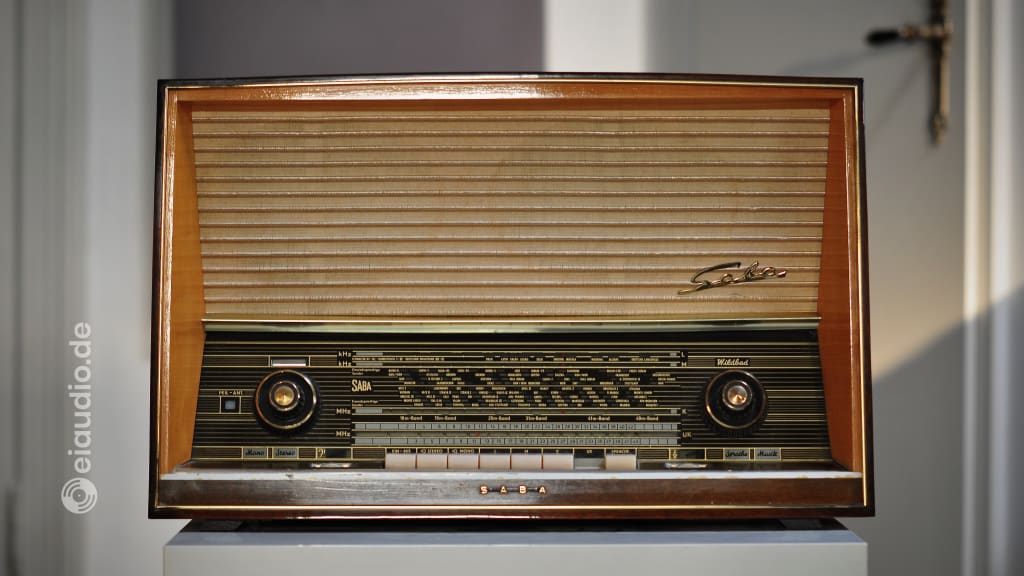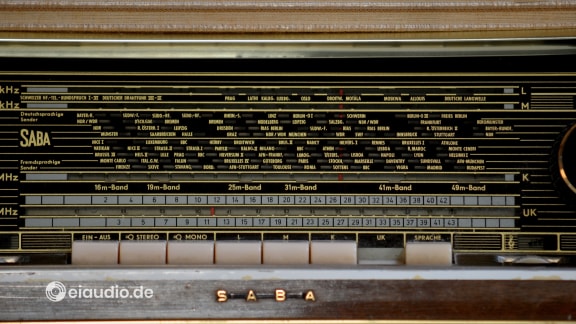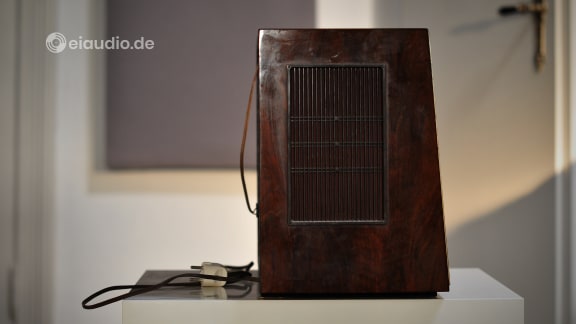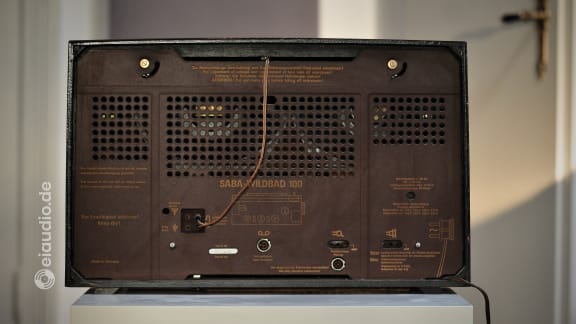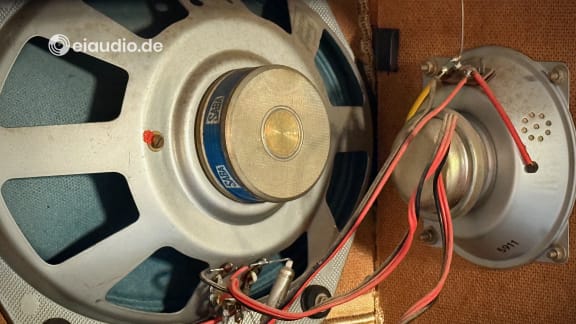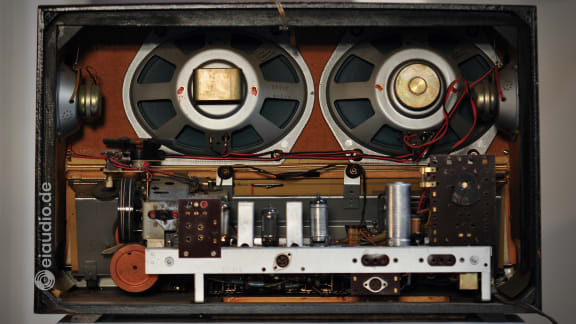Saba Wildbad 100
Published: 06/10/2024
Author: Karsten Hein
Category: Explorations
Tag(s): Vintage Radios
Life could have gone differently for German HiFi, if the industry had fully embraced the idea of creating icons. I love the look and feel of those early days, when anything still seemed possible, and I am thankful to my grandfather for preserving this opportunity for me well beyond his lifetime. So, Rudi, this article is for you.
The Saba Wildbad 100 valve radio, produced from 1959 to 1960, is a classic German radio model with a wooden cabinet, a horizontal station table, and large rotary dials. It operates on the superheterodyne principle and covers frequency bands from long wave (LW) and medium wave (MW) to short wave (SW) and ultra-short wave (FM). The Saba models of this period were renowned for their robust engineering, superior audio quality and meticulous craftsmanship. The Wildbad 100 is no different. It is a respectable member of the collectible vintage Saba line and is still sought after for its sonic fidelity and aesthetic appeal.
My grandfather was a lathe operator and a turner who understood craftsmanship. He was adventurous and a jack-of-all-trades who could fix almost anything in the house. A trained policeman before the war, he also had a sober view of right and wrong and would not tolerate much nonsense from anyone. When he still worked shifts in the factory, he had to plan his free time wisely. In the winter it was mainly family time, which he loved to spend with his grandchildren when we came to visit. Besides working in the garden or building things out of wood and Lego together, I remember sitting with him at dusk, watching the headlights of passing cars create wondrous shapes on the ceiling of the living room, or listening to that very same Saba radio.
Having thrown out his old music chest, my grandfather rebuilt the old Dual turntable (which it had come with) to fit into his sideboard and used his new Wildbad to amplify the sound. He did not own many records—not in the way that collectors do today—but those that he did own he played with great pleasure. His collection contained music ranging from Classical to Folk and German Schlager, but he also had German comedy shows, such as Jürgen von Manger and Emil, which we kids only half understood but somehow greatly enjoyed. Part of the charm of listening sessions with grandpa was in the shared experience, of course. But there was also another kind of warmth that I would come to miss in later years—this warmth came from vinyl as a source and from the radio itself.
Although many performances from the 50s to 80s were poorly recorded, they all possessed a warmth, richness, and sparkle that made listening a pleasure. Looking like a guitar amplifier, the Saba had a resonant wooden body that was closed enough to provide a chamber but open enough not to sound boxy or confined. Unless external speakers and an additional stereo module were present, the output remained mono, coming from a 24cm bass driver, a 24cm midrange driver, and two 10cm tweeters, mostly hidden behind a relatively thick woven fabric. The tweeters were located behind plastic grilles on either side of the cabinet. Both the bass and treble output could be attenuated to adjust the sound to suit the room’s furnishings, proximity to corners, and personal listening preferences. Whatever the setting, the tube-driven Wildbad 100 sounded sonorous and inviting.
Although the Saba Wildbad 100 does not use the now famous Saba Green Cone drivers (which are typically full-range with ALNICO magnets and are found in other models such as the Freiburg series) it does deliver lush and musky vocals and an engaging tonality with sufficient bass slam when driven at moderate living room volumes. Much like the Green Cone drivers, the Wildbad’s set of four drivers will start to sound flat, strained, and distorted when driven too hard. The 4 Watts tube amp power are just enough to reproduce the tonality and the power of a full human voice. In my opinion, it is this discipline that makes the Saba radios of this period so attractive. The Wildbad 100 produces vocals that have tangible substance and an almost forbidden allure.
Pressing the first of the eight ivory buttons on the front, the EM84 tuning indicator tube flickers into action, without the unit making a sound. As the tube warms up to the radio station with an increasingly narrowing band, the sound of the radio begins with heavy distortion, until the amplifier tubes have gathered enough substance to drive the speakers. It then takes another five minutes for the Saba to sound complete and another fifteen minutes for it to sound at its best. Soon, the heat from the tubes can be felt as a warm glow radiating above the wooden cabinet. Consider for a moment the flimsy plastic boomboxes that followed the Saba Wildbad in the 1970s and 1980s. Hardly any of them were tuned to the harmonics of the human voice. As a result, they sounded cold and lifeless by comparison.
When my mother came to visit us at the North Sea a few weeks ago, I gave her a tour of our studio as it is now set up. She listened to our Martin Logan SL3 system with the superb Symphonic Line RG9 MK5 amplifier, Thorens TD 320 turntable, and Marantz CD-17 CD player, as well as to our Tannoy XT8f system with the legendary Symphonic Line RG9 MK3 amplifier. She enjoyed the music very much and became quite emotional at times. Later, as we were sewing the Molton curtains for the listening room, I turned on the Saba Wildbad radio. After some minutes she stopped sewing, and looked up: “Is that my father’s old radio?” She wanted to know. “It’s really very good. I had no idea it could sound like that.” And even though I have gathered lots of experience in setting up systems over the years and now know how to achieve tonal balance even in a complex setup, I was still amazed at the undeniable charm that the Saba Wildbad delivers straight off the bat. Sit with it in the dark for a while, and you will understand why its charm endures.
The SABA History:
SABA is the acronym of Schwarzwälder Apparate-Bau-Anstalt, a privately owned company founded in 1923 in Villingen, Germany, by Hermann Schultze. Initially, it produced clocks and household appliances, but soon expanded into radio technology during the 1920s and 1930s. By the 1950s, the SABA brand had become well-known for its high-quality radios and television sets and gained a reputation for excellent sound quality, especially with models like the Freiburg series that featured the famous automatic station search and high-end "green cone" speakers.
In the 1960s, SABA began producing televisions and ventured into consumer electronics. However, increased competition from international companies during the 1970s affected its financial stability. The company was eventually acquired by the French Thomson-Brandt group in 1980, which marked the end of its independence. Despite this, the SABA brand persisted in various forms, especially in the TV market and under Thomson's ownership. SABA remains a nostalgic brand, which is admired for its craftsmanship in radio and audio technologies, particularly during its mid-20th-century heyday.
Technical Specifications:
- Type: Post-World War II tube radio
- Power consumption (max.): 70 Watt
- Power supply: 110V, 125V, 150V, 220V AC
- Amplifier output (max.): 4 watts
- Loudspeakers: 2x 10 cm (round), 2x 24 cm (oval)
- Cabinet finish: wood, glossy walnut finish
- Dimensions: (W) 592 mm x (H) 375 mm x (D) 255 mm (23.3 in x 14.8 in x 10.1 in)
- Weight: 11 kg (24 lbs)
- Country of manufacture: Germany
- Year(s): 1959 - 1960
Tubes (Valves) Used:
- ECC85 (FM frequency converter)
- ECH81 (AM frequency converter)
- EF89 (Intermediate frequency amplifier)
- EABC80 (Detector and audio pre-amplifier)
- EL84 (Power amplifier)
- EM84 (Tuning indicator)


